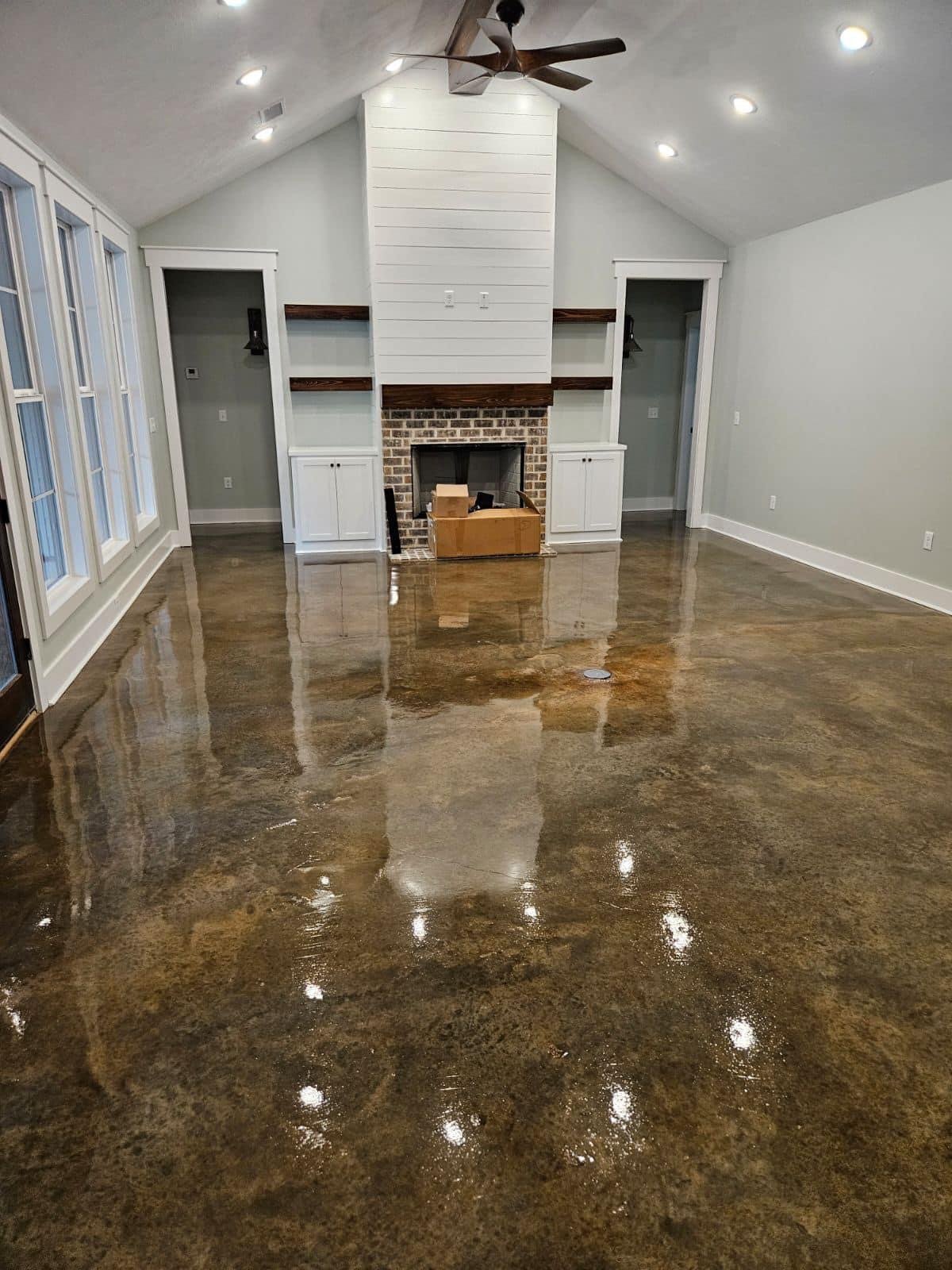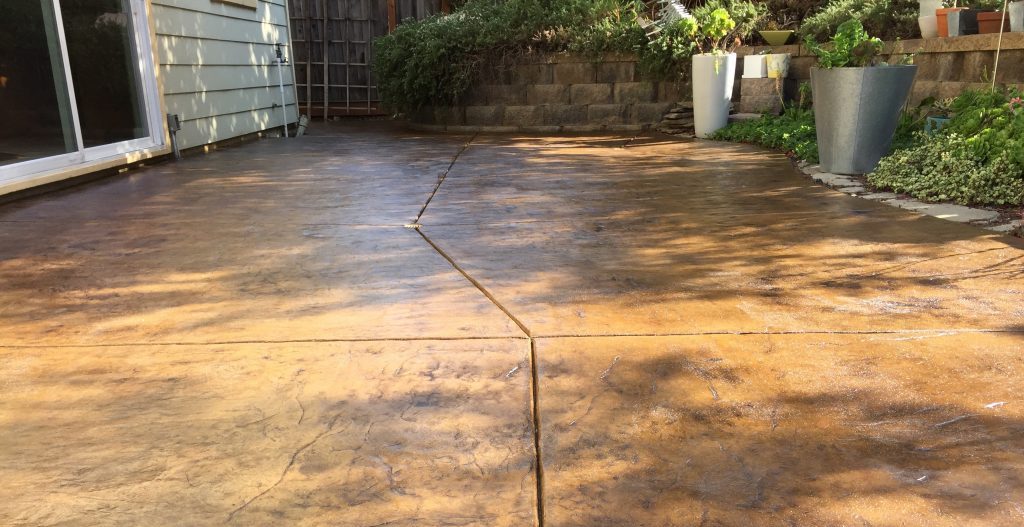Comprehending the Different Kinds Of Stained Concrete for Your Following Task
Stained concrete deals various options that provide to different aesthetic and useful needs. Each type offers distinct features that influence the final appearance and sturdiness of the surface area. Comprehending these distinctions is vital for anybody preparing a task. From rich, chain reactions of acid-based stains to the vibrant uniformity of solid shade stains, the selections can substantially impact the result. What elements should one consider when selecting the optimal tarnish for their specific needs?
Summary of Stained Concrete
Stained concrete serves as a functional flooring option that can enhance the visual appeal of different rooms. This method includes applying a coloring agent to the surface of existing concrete, permitting a wide range of design possibilities. Stained concrete is preferred in both property and industrial atmospheres, offering a sturdy and low-maintenance solution that can simulate the appearance of natural materials like stone or tile.
The discoloration procedure can be executed using water-based or solvent-based items, each providing unique visual results. The final appearance is affected by aspects such as the original concrete surface, the sort of discolor utilized, and the application technique. Stained concrete not just improves exterior and interiors but also promotes sustainability by revitalizing existing concrete structures. Therefore, it has actually obtained grip among home owners and developers seeking both performance and style in their flooring choices.
Acid-Based Stains: Characteristics and Benefits

Special Color Variants
Concrete surfaces can change significantly with the application of acid-based stains, which provide an abundant scheme of one-of-a-kind color variations. These stains pass through the concrete, responding chemically to produce vivid planet tones that range from deep browns and reds to soft environment-friendlies and blues. The resulting colors are typically variegated, developing an all-natural, marble-like look that boosts the concrete's personality. Each application yields unique outcomes as a result of variations in the concrete's make-up and the discoloration technique used, making every project unique. In addition, acid-based stains can be layered or incorporated with other strategies to create customized designs, permitting personal expression. This flexibility makes acid-based stains a prominent choice for both property and commercial applications.
Chemical Responses Explained
While many variables add to the effectiveness of acid-based stains, the underlying chemical reactions play an essential duty in their distinct characteristics and benefits. These stains mainly contain water, acid, and metal salts. When used to concrete, the acid reacts with the calcium hydroxide in the cement, producing a chemical change that leads to long-term color changes. The metal salts pass through the surface area and bond with the concrete, permitting a wide variety of shades and tones. This response not just boosts aesthetic charm yet likewise supplies resilience, making the color resistant to fading and wear. Additionally, acid-based stains can develop a variegated surface that simulates natural rock, more boosting their popularity for attractive concrete applications.
Surface Prep Work Significance
Accomplishing optimal outcomes with acid-based stains rests on extensive surface prep work. This necessary step warranties that the concrete surface area is clean, without impurities, and appropriately profiled for excellent tarnish absorption. Any type of existing sealers, dust, or oils can hinder the chemical reaction that produces the wanted color and coating, resulting in unequal or irregular outcomes.
Before using the tarnish, the concrete should be mechanically cleaned up or pressure washed, followed by a detailed evaluation for splits or flaws that may need repair service. Additionally, confirming the surface area is effectively dried out will enhance stain adherence. By prioritizing these preparatory actions, the durability and vibrancy of acid-based stains can be considerably enhanced, leading to a much more aesthetically pleasing and durable surface.
Water-Based Stains: Functions and Advantages

Water-based stains penetrate the concrete, providing an extra transparent coating that highlights the natural structure and variations of the surface area below. They are available in a wide selection of shades, enabling imaginative adaptability in style. In addition, water-based stains are simpler to tidy up, requiring just water and soap, which streamlines the application procedure.
Their fast drying out time boosts performance, making them a useful option for both DIY lovers and experts. Generally, water-based stains supply an attractive mix of visual flexibility and straightforward residential or commercial properties, making them a preferred choice for concrete enhancement projects.
Solid Color Stains: Vibrant Choices for a Strong Appearance
Strong color stains offer an efficient option for those seeking to produce a vibrant and lively aesthetic on concrete surface areas. These stains offer an uniform coloration that can significantly boost the visual appeal of floorings, patios, and driveways. Available in a broad spectrum of shades, strong color stains allow for creative expression, dealing with various design choices.
Among the essential benefits of strong color stains is their capacity to hide flaws, giving a fresh and refined aim to maturing concrete - Stained Concrete Floors Austin Tx. Additionally, their formula typically includes UV-resistant properties, making sure long life and color retention even in severe weather problems
Application is straightforward, requiring minimal preparation of the concrete surface area. As soon as applied, strong color stains can be sealed for added security and shine, more raising their visual top quality. With their vibrant choices, solid shade stains are an excellent choice for those going for an impactful and cohesive design.
Semi-Transparent Stains: Achieving Deepness and Measurement
Semi-transparent stains offer an one-of-a-kind approach to boosting concrete surface areas by supplying deepness and dimension via numerous shade options. Understanding the application techniques is important for accomplishing the wanted impact, while correct upkeep methods assure long life. This area will certainly discover these crucial facets to optimize the benefits of semi-transparent discoloration.
Shade Options Available
A variety of shade alternatives exists for semi-transparent stains, permitting homeowners and designers to improve the all-natural beauty of concrete surface areas. These stains are available in a variety of hues, from earthy tones like browns and terracottas to vivid colors such as blues and environment-friendlies. The semi-transparent nature of these stains permits the underlying concrete to show with, producing an unique depth and dimension that can enhance different style aesthetics. Additionally, incorporating different shades can create custom-made tones, allowing a customized try to find each task. This flexibility makes semi-transparent stains a prominent choice for both exterior pop over to these guys and interior applications, as they can balance with surrounding components while including visual interest to simple concrete.
Application Techniques Discussed
To achieve the wanted deepness and dimension with semi-transparent stains, correct application techniques are important. Surface area prep work is vital; the concrete should be clean and complimentary of any pollutants. This frequently includes power cleaning and fixing any type of cracks. Next off, choosing the appropriate applicator, such as a sprayer, roller, or brush, can influence the final look. Sprayers enable for a much more also application, while rollers can aid achieve appearance. It is vital to apply the discolor in thin, even coats, enabling each layer to dry prior to adding an additional. Manipulating the application technique, such as differing stress or making use of various tools, can produce special effects. Sealing the stained surface improves the vibrancy of the shades while offering protection.
Upkeep Finest Practices
Routine upkeep is vital for protecting the elegance and stability of surface areas treated with semi-transparent stains. To preserve these surfaces, routine cleaning is essential. Making use of a pH-neutral cleaner and a soft-bristle mop will certainly assist remove dust and particles without harming the discolor. It is recommended to avoid rough chemicals, as they can degrade the stain's look. In addition, regular resealing each to three years can safeguard versus wear and fading. This procedure involves cleaning up the surface extensively and applying a compatible sealant made for stained concrete. Home owners need to additionally monitor for any type of indicators of discoloration or damage and address these concerns immediately to guarantee durable vibrancy and sturdiness. Adhering to these ideal methods will certainly boost the overall life expectancy of semi-transparent stained surface areas.
Results and Methods: Tailoring Your Stained Concrete
Customizing stained concrete includes a range of techniques that boost both aesthetics and performance. Among these methods, layering different tarnish shades can produce deepness and complexity, enabling distinct aesthetic impacts. Strategies such as acid staining offer a variegated look, while water-based stains use an extra uniform look.
Additionally, integrating attractive patterns, such as stenciling or inscription, can better customize the surface, adding complex styles that deal with specific tastes. Texturing the concrete, whether with stamping or broom coatings, presents tactile elements that not only enhance grasp yet likewise improve visual rate of interest.
Furthermore, using sealers can intensify the shade vibrancy and provide defense against wear. Personalization methods expand past mere shade; they can transform a conventional concrete slab into a magnificent prime focus, making it suitable for both residential and commercial areas. With cautious selection of effects and techniques, stained concrete can achieve a truly customized appearance.
Maintenance and Longevity of Stained Surfaces
Although stained concrete surfaces are known for their toughness and visual appeal, keeping their integrity is important for ensuring longevity. Normal cleansing is vital; sweeping and wiping with a pH-neutral cleaner assists avoid dust buildup and discoloration. Additionally, applying a sealant every couple of years can shield the surface area from moisture, chemicals, and UV damages, thus improving its life expectancy.
It is also important to attend to any type of splits or chips immediately. Small repair services can mitigate further degeneration, maintaining the aesthetic and structural high quality of the surface area. For exterior stained concrete, seasonal maintenance, such as getting rid of snow and ice, is needed to protect against surface damage from freeze-thaw cycles.
Regularly Asked Inquiries
Can I Stain Existing Concrete Surfaces or Only Brand-new Ones?
The inquiry of whether existing concrete surface areas can be stained emerges regularly. It is undoubtedly possible to tarnish both new and old concrete, offered the surface area is effectively ready and without pollutants for optimal attachment.
How Long Does the Staining Process Generally Take?
The staining process typically takes one to 3 days, depending upon variables such as surface area prep work, kind of stain, and climate condition. Stained Concrete Floors Austin Texas. Healing time may prolong past initial application, affecting the general period significantly
Is Stained Concrete Safe for Outdoor Usage?
Stained concrete is typically safe for outdoor use, supplied it try this is appropriately secured. This weblink sealing protects versus wetness and UV damage, guaranteeing durability and security, while also boosting the aesthetic allure of outside areas.
Can I Use Several Discoloration Layers for Different Impacts?
Applying multiple stain layers can accomplish varied effects on stained concrete. Nevertheless, it is necessary to assure compatibility between stains and permit appropriate drying out time between applications to prevent unexpected reactions or discoloration.
Are There Any Type Of Shade Limitations for Stained Concrete?
Color constraints for stained concrete mainly depend upon the sort of stain made use of, with water-based stains supplying a more comprehensive combination contrasted to acid-based stains. Stained Concrete Floors Austin Texas. Achieving lively colors might need careful choice and application methods.